Transaction In Sql Stored Procedure
A. Definition and purpose of stored procedures
A stored procedure in SQL is a named group of SQL statements that are precompiled and stored in the database. They are designed to perform specific tasks and can be executed by calling their name. Stored procedures allow for code reusability, modularity, and security since they can be accessed by multiple users and can be granted specific permissions.
B. Advantages of using stored procedures
There are several advantages to using stored procedures in SQL:
1. Improved performance: By precompiling the SQL statements, stored procedures can be executed much faster than ad-hoc queries. This helps to reduce network traffic and improve overall database performance.
2. Code reuse: Stored procedures can be called from multiple applications and can be shared across different modules or projects. This eliminates the need to write the same SQL code repeatedly, improving both development time and code maintenance.
3. Enhanced security: Stored procedures can be designed to execute with specific user permissions, ensuring that only authorized users can access and modify the data.
4. Simplified maintenance: Since the SQL code is stored centrally in the database, any changes or updates can easily be made in one place. This reduces the chances of introducing errors and simplifies the maintenance process.
II. Understanding Transactions in SQL
A. Definition of a transaction and its importance
In SQL, a transaction is a sequence of SQL statements that are treated as a single unit of work. They are used to ensure data integrity and consistency within a database. A transaction can be considered a logical and atomic operation, meaning that it either succeeds completely or fails entirely.
Transactions are important because they allow multiple SQL statements to be grouped together and executed as a single unit. If any part of the transaction fails, all the changes made within it can be rolled back, ensuring that the database remains in a consistent state.
B. ACID properties of transactions
Transactions in SQL follow the ACID properties, which stand for:
1. Atomicity: This property ensures that a transaction is treated as a single, indivisible unit of work. If any part of the transaction fails, all changes made within it are rolled back, leaving the database in its original state.
2. Consistency: Transactions ensure that the database moves from one consistent state to another. The data modifications made within a transaction must adhere to the defined rules and constraints of the database, maintaining its integrity.
3. Isolation: Transactions provide isolation between concurrent transactions. Each transaction operates independently, and the changes made in one transaction are not visible to other transactions until the changes are committed.
4. Durability: Once a transaction is committed, its changes are permanent and remain in the database even in the event of a system failure or restart.
III. Incorporating Transactions into SQL Stored Procedures
A. Syntax and structure for defining transactions in stored procedures
To define a transaction in a stored procedure, the following syntax can be used:
BEGIN TRANSACTION;
— SQL statements to be executed within the transaction
COMMIT TRANSACTION;
Within a stored procedure, one or multiple SQL statements can be enclosed within the BEGIN TRANSACTION and COMMIT TRANSACTION statements to form a transaction.
B. An example of a simple transaction in a stored procedure
Here is an example of a simple transaction in a stored procedure that inserts data into two related tables:
CREATE PROCEDURE InsertCustomerOrder
(
@CustomerID INT,
@OrderID INT,
@OrderDate DATE
)
AS
BEGIN
BEGIN TRANSACTION;
INSERT INTO Customers (CustomerID) VALUES (@CustomerID);
INSERT INTO Orders (OrderID, CustomerID, OrderDate) VALUES (@OrderID, @CustomerID, @OrderDate);
COMMIT TRANSACTION;
END;
In this example, the transaction starts with the BEGIN TRANSACTION statement and ends with the COMMIT TRANSACTION statement. If both insert statements succeed, the changes will be committed, and if any of them fail, the transaction will be rolled back.
IV. Managing Transaction State in Stored Procedures
A. Begin transaction and commit transaction statements
To start a transaction in a stored procedure, the BEGIN TRANSACTION statement is used. This marks the beginning of the transaction and allows the SQL statements within the procedure to be treated as a single unit of work.
To commit a transaction and make the changes permanent, the COMMIT TRANSACTION statement is used. This should be placed at the end of the transaction, after all the desired changes have been made.
B. Rollback statement to undo a transaction
If at any point within the transaction an error occurs or a specific condition is not met, the ROLLBACK statement can be used to undo all the changes made within the transaction. This ensures that the database remains in a consistent state and no partial changes are persisted.
V. Error Handling in SQL Stored Procedures
A. Handling errors within transactions
When errors occur within a transaction, it is important to handle them appropriately to ensure data integrity. This can be done by using structured exception handling, such as try-catch blocks, within the stored procedure.
B. Using try-catch blocks in stored procedures
Try-catch blocks allow for the capture and handling of exceptions within a stored procedure. By enclosing the SQL statements within a try block and specifying a catch block, any errors that occur within the try block can be caught and processed.
Here is an example of a stored procedure with error handling using a try-catch block:
CREATE PROCEDURE UpdateCustomer
(
@CustomerID INT,
@NewName NVARCHAR(50)
)
AS
BEGIN
BEGIN TRY
BEGIN TRANSACTION;
UPDATE Customers SET Name = @NewName WHERE CustomerID = @CustomerID;
COMMIT TRANSACTION;
END TRY
BEGIN CATCH
ROLLBACK TRANSACTION;
— Error handling logic
— Log the error, display an error message, etc.
END CATCH
END;
In this example, if an error occurs during the update statement, the transaction is rolled back, and the error can be handled within the catch block.
VI. Best Practices for Utilizing Transactions in Stored Procedures
A. Avoiding nested transactions
Nested transactions should be avoided whenever possible since they can complicate the logic and lead to potential issues. Instead, it is recommended to use a single transaction that encompasses all the necessary SQL statements.
B. Ensuring proper locking and isolation levels
To ensure data integrity and prevent concurrency issues, it is important to use proper locking and isolation levels within transactions. This helps to control the access and modification of data by concurrent transactions.
FAQs:
1. What is a stored procedure in SQL?
A stored procedure in SQL is a named group of precompiled SQL statements that are stored in the database. They are designed to perform specific tasks and can be executed by calling their name.
2. What are the advantages of using stored procedures?
Some advantages of using stored procedures include improved performance, code reuse, enhanced security, and simplified maintenance.
3. What is a transaction in SQL?
A transaction in SQL is a sequence of SQL statements treated as a single unit of work. They are used to ensure data integrity and consistency within a database.
4. What are the ACID properties of transactions?
The ACID properties of transactions are atomicity, consistency, isolation, and durability. These properties ensure that transactions are reliable and maintain data integrity.
5. How can transactions be incorporated into stored procedures?
Transactions can be incorporated into stored procedures by using the BEGIN TRANSACTION and COMMIT TRANSACTION statements to define the boundaries of the transaction.
6. How can errors be handled within transactions in stored procedures?
Errors within transactions can be handled using try-catch blocks within the stored procedure. This allows for the capture and processing of exceptions.
7. What are some best practices for utilizing transactions in stored procedures?
Some best practices for utilizing transactions in stored procedures include avoiding nested transactions and ensuring proper locking and isolation levels are used.
Stored Procedures-03 Stored Procedures For Transactions
Can We Use Transaction In Stored Procedure?
Transactions are an essential part of any database management system. They ensure consistency, durability, and integrity of data by grouping multiple related operations into a single logical unit of work. In most cases, transactions are typically used within application code to handle database operations, but can we also use transactions within stored procedures? In this article, we will explore the concept of using transactions within stored procedures and discuss their benefits, limitations, and best practices.
Understanding Stored Procedures
Before diving into the topic of using transactions within stored procedures, let’s first understand what a stored procedure is. A stored procedure is a set of pre-compiled SQL statements and procedural logic that is stored in a database. It is designed to be reusable and can be invoked by applications or other stored procedures.
Stored procedures are commonly used to encapsulate business rules, implement complex calculations, and perform data manipulation. They offer several advantages such as improved performance, enhanced security, reduced network traffic, and easier maintenance. Transactions within stored procedures can provide an additional layer of control and ensure data integrity.
Using Transactions within Stored Procedures
Yes, we can certainly use transactions within stored procedures. Incorporating transactions into stored procedures allows us to group multiple SQL statements together and ensure that they either all succeed or all fail as a single unit. By using transactions, we can avoid inconsistent and corrupted data that may result from partial execution of a set of related operations.
Transactions within stored procedures can be defined using the BEGIN TRANSACTION, COMMIT, and ROLLBACK statements. These statements allow us to start a transaction, commit the changes made during the transaction, or roll back the changes to the initial state, respectively.
Benefits of Using Transactions
Using transactions within stored procedures provides several benefits that contribute to database reliability and consistency. Let’s highlight some key advantages:
1. Atomicity: Transactions ensure that a group of related operations are treated as a single unit. If any operation within the transaction fails, all changes made during that transaction can be rolled back, keeping the database in a consistent state.
2. Consistency: By using transactions, we can enforce data integrity rules within the database. For example, if a stored procedure needs to perform multiple updates across different tables, a transaction can ensure that all updates are completed successfully or none at all, maintaining data consistency.
3. Isolation: Transactions provide isolation to concurrent operations, preventing data corruption and ensuring that each operation within the transaction sees a consistent and isolated view of the data. This avoids conflicts and inconsistencies caused by multiple processes accessing and modifying the same data simultaneously.
Limitations and Best Practices
While using transactions within stored procedures offers numerous benefits, it is important to be aware of the potential limitations and follow best practices:
1. Performance Impact: Transactions can introduce overhead because they acquire locks on the data being modified. As a result, other operations trying to access the same data may be blocked, impacting performance. It is necessary to carefully analyze the performance implications of using transactions within stored procedures and consider alternative approaches when required.
2. Transaction Scope: Take care to ensure that the transaction scope is appropriate within the stored procedure. It is essential to balance the need for atomicity and isolation against the potential impact on performance and concurrency.
3. Exception Handling: Proper exception handling is crucial when using transactions within stored procedures. It is essential to handle exceptions and roll back the changes made during the transaction to avoid leaving the database in an inconsistent state.
FAQs
Q1. Can we use nested transactions within stored procedures?
A1. No, nested transactions are not supported within stored procedures. Once a transaction is started within a stored procedure, it should be committed or rolled back as a whole.
Q2. Can we use transactions across multiple stored procedures?
A2. Yes, transactions can span multiple stored procedures. By encapsulating related stored procedures within a single transaction, we can ensure that all changes made by these procedures are consistent and atomic.
Q3. Can we use transactions within triggers?
A3. Yes, transactions can also be used within triggers to maintain data integrity and consistency.
Conclusion
Transactions play a critical role in maintaining data integrity and consistency within a database. While they are commonly used within application code, transactions can also be utilized within stored procedures. By using transactions, we can ensure that a group of related database operations are treated as a single unit, avoiding potential inconsistencies or corruptions. However, it is important to carefully consider the implications and follow best practices to achieve a balance between database reliability, performance, and concurrency.
Can We Use Transaction In Stored Procedure Sql Server?
The use of transactions is a crucial aspect of a well-designed database application. Transactions provide a way to ensure data integrity and consistency by grouping related database operations into a single logical unit. In SQL Server, transactions can be implemented at various levels, including at the application level or within stored procedures.
Stored procedures are reusable database objects that contain a set of pre-defined SQL statements. They are commonly used to encapsulate complex business logic and provide a modular approach to database management. One of the advantages of using stored procedures is the ability to implement transactions directly within them.
Transactions in stored procedures enable the grouping of multiple SQL statements into a single transaction, ensuring that all operations either succeed or fail together. If any part of the transaction fails, the entire set of changes is rolled back, reverting the database back to its original state. This guarantees the atomicity of operations, preventing data corruption and ensuring data consistency.
To use transactions in a stored procedure in SQL Server, the BEGIN TRANSACTION statement is used to mark the beginning of a transaction. This is followed by a series of SQL statements that make up the body of the transaction. At the end, the transaction is either committed (using the COMMIT statement) if all operations were successful, or rolled back (using the ROLLBACK statement) if an error occurs.
Here is an example of a stored procedure that uses a transaction:
“`
CREATE PROCEDURE sp_UpdateCustomerAndOrder
@customerId INT,
@orderId INT,
@newCustomerName NVARCHAR(100),
@newOrderStatus NVARCHAR(50)
AS
BEGIN
BEGIN TRANSACTION
BEGIN TRY
— Update the customer name
UPDATE Customers
SET CustomerName = @newCustomerName
WHERE CustomerId = @customerId
— Update the order status
UPDATE Orders
SET OrderStatus = @newOrderStatus
WHERE OrderId = @orderId
— Commit the transaction if no errors occurred
COMMIT
END TRY
BEGIN CATCH
— Rollback the transaction if an error occurred
ROLLBACK
END CATCH
END
“`
In this example, the stored procedure “sp_UpdateCustomerAndOrder” updates both the customer name and order status in their respective tables. The transaction ensures that the updates to both tables are performed as an atomic operation. If any errors occur during the execution of the stored procedure, the transaction is rolled back, and no changes are applied to the database.
FAQs:
Q: Why should we use transactions in stored procedures?
A: Transactions provide a way to ensure data integrity and consistency by grouping related database operations. By using transactions in stored procedures, we can guarantee that a group of changes either succeeds or fails together.
Q: Can we use nested transactions in stored procedures?
A: In SQL Server, nested transactions are supported but should be used with caution. If a nested transaction fails, the entire set of changes will be rolled back, even if the outer transaction was successful.
Q: Can we roll back a specific part of a transaction without rolling back the entire transaction?
A: In SQL Server, it is not possible to roll back a specific part of a transaction without rolling back the entire transaction. Transactions are designed to be atomic, ensuring that either all changes succeed or none of them do.
Q: Are transactions automatically committed in stored procedures?
A: No, transactions in stored procedures need to be explicitly committed using the COMMIT statement. If a transaction is not committed or rolled back, SQL Server will automatically roll it back when the stored procedure exits.
Q: Can we combine transactions in stored procedures with error handling?
A: Yes, SQL Server provides error handling mechanisms such as the TRY-CATCH construct. By combining transactions with error handling, we can ensure that any errors within the transaction are caught, and the transaction is rolled back accordingly.
In conclusion, the use of transactions in stored procedures is crucial for maintaining data integrity and consistency. It allows for the grouping of related database operations into a single logical unit. By implementing transactions within stored procedures, we ensure that changes are either applied as a whole or not at all. This provides a safeguard against data corruption and guarantees data consistency in SQL Server databases.
Keywords searched by users: transaction in sql stored procedure Transaction in stored procedure, Use transaction in sql server stored procedure, Transaction in SQL Server, ROLLBACK TRANSACTION in stored procedure SQL Server, Transaction in procedure MySQL, SQL transaction, SELECT from EXEC stored procedure, How to make data stored permanently when use database transaction
Categories: Top 64 Transaction In Sql Stored Procedure
See more here: nhanvietluanvan.com
Transaction In Stored Procedure
In the world of databases, transactions play a crucial role in maintaining the integrity and consistency of data. Transactions allow users to group a series of database operations together into a single logical unit, ensuring that either all the operations are successfully completed or none of them are. This concept of atomicity becomes even more relevant when dealing with complex operations, where failure of a single step can lead to disastrous consequences.
One of the most powerful tools for managing transactions in a database is the stored procedure. A stored procedure is a set of predefined SQL statements which are executed as a single unit, allowing for greater control and efficiency. In this article, we will explore the concept of transactions within stored procedures, their importance, implementation, and some frequently asked questions related to this topic.
Why are transactions important in stored procedures?
Transactions serve as a safeguard mechanism, ensuring the completion of a series of operations. In the context of stored procedures, they allow for the execution of multiple SQL statements, keeping the data consistent and reducing the chances of data corruption. Transactions offer the following benefits within stored procedures:
1. Consistency: By committing or rolling back all operations within a transaction, stored procedures help maintain the integrity and consistency of data. This is especially useful when multiple updates or inserts need to be performed in a single logical operation.
2. Error Handling: Transactions enable the implementation of error handling mechanisms within the stored procedure. In case an error occurs during the execution of a statement, the transaction can be rolled back, undoing all the changes made so far.
3. Isolation: Transactions provide isolation to the operations within a stored procedure. This means that while a transaction is in progress, the data accessed by other users or processes remains unaffected. This prevents conflicts and ensures that each transaction is executed independently.
Implementing transactions in stored procedures:
To implement transactions within a stored procedure, several steps need to be followed:
1. Begin Transaction: The first step is to start a transaction using the BEGIN TRANSACTION statement. This marks the beginning of a transaction and sets a savepoint, allowing for easy rollback in case of an error.
2. Execute Statements: Within the transaction, execute the required SQL statements. These statements can include updates, inserts, deletes, or any other operation needed to be performed.
3. Error Handling: Implement error handling using TRY-CATCH blocks. This allows for the detection of any errors that may occur during the execution of the statements and provides a mechanism to handle them gracefully.
4. Commit or Rollback: After the execution of all statements within the transaction, decide whether to commit or rollback the transaction. If all statements executed successfully and the data is in the desired state, commit the transaction using the COMMIT statement. If an error occurred, rollback the transaction using the ROLLBACK statement to undo all the changes made so far.
Frequently Asked Questions (FAQs):
Q1: Can transactions be nested within stored procedures?
Yes, transactions can be nested within stored procedures. This means that a stored procedure can contain multiple transactions, each with its own set of SQL statements. However, care should be taken to ensure that proper commit or rollback statements are used at appropriate points to maintain data integrity.
Q2: Can transactions be rolled back automatically?
No, transactions should be explicitly rolled back or committed. If a transaction is not explicitly rolled back or committed when an error occurs, the database management system will generally roll it back automatically to maintain the integrity of the data.
Q3: Can stored procedures be called within a transaction?
Yes, stored procedures can be called within a transaction. When a stored procedure is called within a transaction, it becomes a part of the ongoing transaction and follows the same commit or rollback rules. This allows for the execution of complex operations that involve multiple stored procedures.
Q4: Can transactions be used in conjunction with other database operations?
Yes, transactions can be used in conjunction with other database operations such as locks, triggers, and constraints. Transactions work alongside these mechanisms to ensure data integrity and consistency, providing a comprehensive approach to database management.
Q5: Can transactions be rolled back partially?
No, transactions cannot be rolled back partially. Once a transaction is rolled back, all the changes made within the transaction are undone, reverting the data to its previous state. If partial rollback behavior is desired, different transactions should be used.
In conclusion, transactions are a vital aspect of stored procedures. They provide consistency, error handling, and isolation, ensuring the integrity of the data. Understanding the implementation of transactions within stored procedures is crucial for database administrators and developers to design efficient and secure database systems.
Use Transaction In Sql Server Stored Procedure
In the world of database management, transactions play a vital role in ensuring data integrity and consistency. A transaction is a logical unit of work that consists of one or more operations, and it is crucial to handle them efficiently to prevent any data anomalies or inconsistencies. SQL Server provides developers with various mechanisms to manage transactions, and one of the commonly used techniques is by utilizing transactions in stored procedures.
What is a stored procedure?
Before diving into the details of transaction management, let’s briefly cover the concept of a stored procedure. In SQL Server, a stored procedure is a pre-compiled block of SQL statements that performs a specific task or a set of related tasks. It helps in improving performance, code reusability, and security by encapsulating the SQL logic within a single entity.
Understanding transactions in SQL Server:
A transaction in SQL Server represents a sequence of SQL statements that should be treated as a single unit of work. The primary purpose of using transactions is to ensure that all the operations within the transaction are executed atomically, either all of them succeed or none of them succeed. This property of transactions is known as atomicity.
Transactions abide by the ACID (Atomicity, Consistency, Isolation, Durability) properties, which ensure that the database remains in a reliable state at all times. ACID properties guarantee consistency by rolling back all the changes made within a transaction if any error occurs during its execution.
Using transactions in stored procedures:
To utilize transactions in a stored procedure, you need to mark the beginning and end of the transaction using the BEGIN TRANSACTION and COMMIT/ROLLBACK statements, respectively. The BEGIN TRANSACTION statement indicates the start of a new transaction, whereas the COMMIT statement commits and permanently applies all the changes made within the transaction to the database. On the other hand, the ROLLBACK statement rolls back the entire transaction, undoing all the changes made within it.
Here’s an example to illustrate the usage of transactions in stored procedures:
“`sql
CREATE PROCEDURE dbo.InsertEmployee
(
@FirstName VARCHAR(50),
…
— Other parameters
)
AS
BEGIN
BEGIN TRANSACTION;
BEGIN TRY
— Perform operations
INSERT INTO Employees (FirstName, …) VALUES (@FirstName, …);
…
COMMIT;
END TRY
BEGIN CATCH
ROLLBACK;
— Handle the exception or re-throw.
END CATCH
END
“`
In the above example, a stored procedure named “InsertEmployee” is created to insert a new employee record into the “Employees” table. The transaction encapsulates the entire operation inside a TRY-CATCH block. If any error occurs during the execution of the transaction, it gets caught in the CATCH block, and the ROLLBACK statement is executed to undo the changes made.
FAQs:
1. Why should I use transactions in stored procedures?
Using transactions in stored procedures ensures data integrity and consistency by treating a set of operations as a single atomic unit of work. It helps in maintaining the integrity of the database by rolling back changes if any error occurs.
2. Can I nest transactions within a stored procedure?
No, SQL Server does not support nested transactions. However, you can implement a similar behavior using savepoints and the ROLLBACK TRAN statement.
3. How can I handle exceptions within a transaction in a stored procedure?
You can use the TRY-CATCH construct in SQL Server to handle exceptions within a transaction. In case of an error, the control transfers to the CATCH block where you can either handle the exception or re-throw it.
4. What happens if the stored procedure encounters an error without a transaction?
If a stored procedure encounters an error without a transaction, the changes made until that point will be permanently stored in the database. In such cases, it becomes challenging to ensure data consistency and recover from the error state.
5. Can I explicitly start a new transaction within a stored procedure if a transaction is already active?
No, SQL Server does not allow starting a new transaction within a stored procedure if a transaction is already active. However, you can implement a workaround by using savepoints and the ROLLBACK TRAN statement.
In conclusion, transactions in SQL Server stored procedures are crucial for maintaining data integrity and consistency. By using the BEGIN TRANSACTION, COMMIT, and ROLLBACK statements, developers can ensure that a set of operations is executed atomically. Understanding transaction management is vital to avoid data inconsistencies and recover from error states effectively.
Images related to the topic transaction in sql stored procedure

Found 45 images related to transaction in sql stored procedure theme
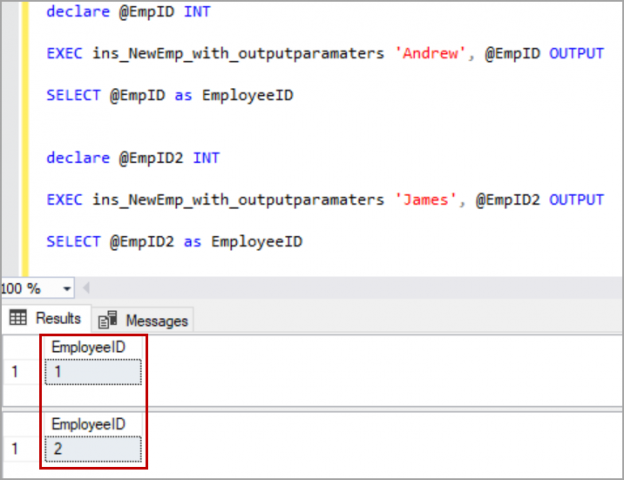
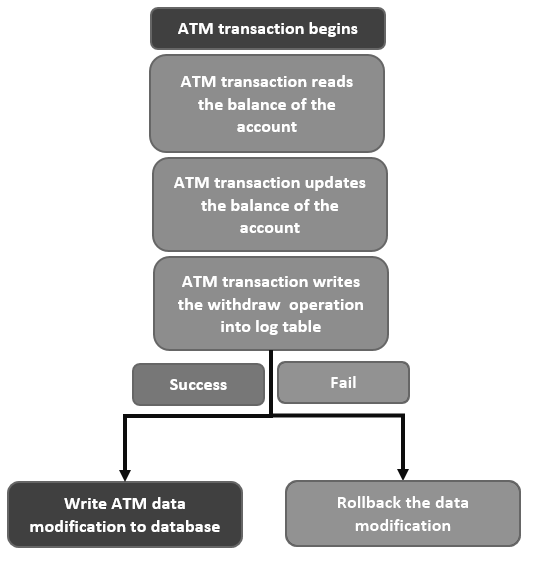
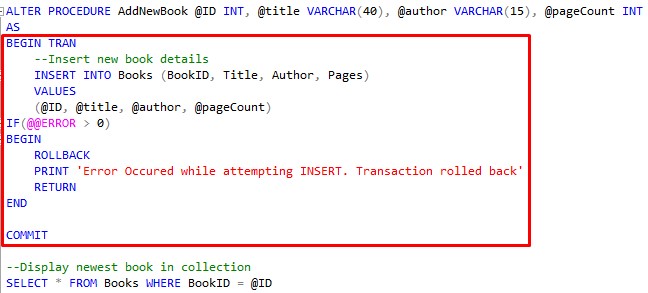
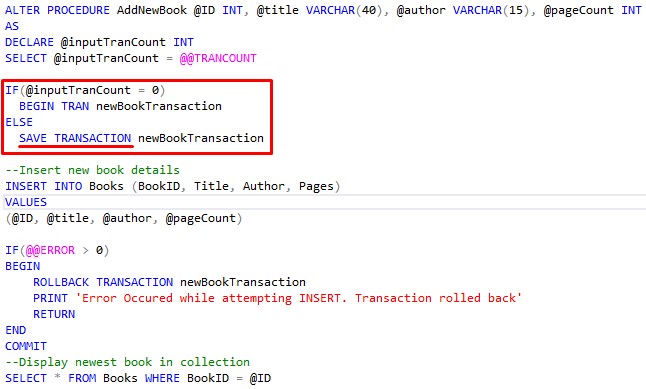


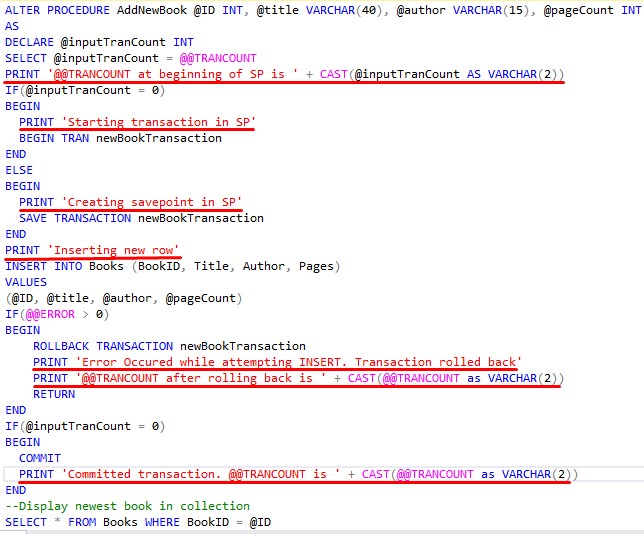





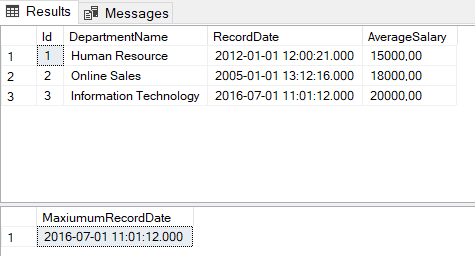



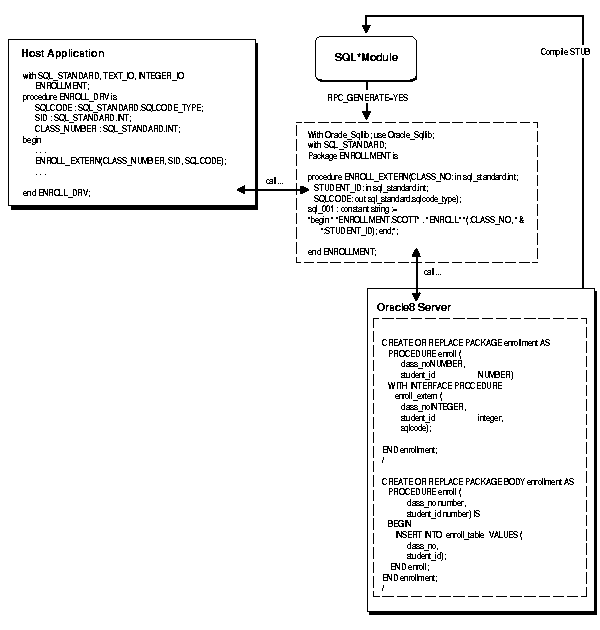

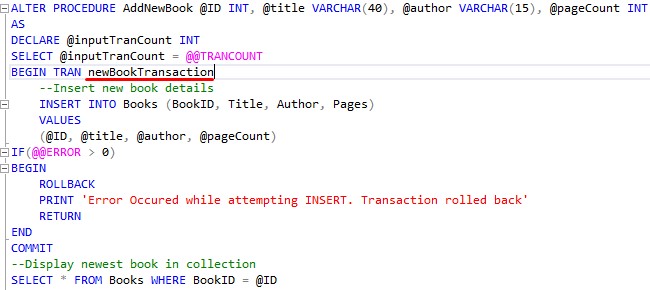
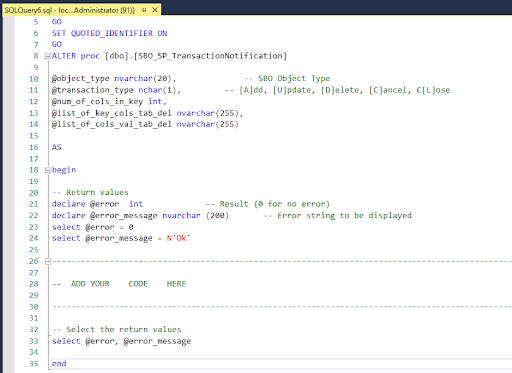












Article link: transaction in sql stored procedure.
Learn more about the topic transaction in sql stored procedure.
- Transaction in stored procedure in SQL Server – Tech Funda
- Transaction in a stored procedure – DBA Stack Exchange
- SQL Server : stored procedure transaction – Stack Overflow
- Transaction commits and rollbacks in stored procedures – IBM
- Transaction in stored procedure in SQL Server – Tech Funda
- Difference between Trigger and Stored procedure in DBMS
- A Primer on SQL Transactions | Linode Docs
- Handling Transactions in Nested SQL Server Stored Procedures
- Transaction commits and rollbacks in stored procedures – IBM
- How to Use Transaction in SQL Server? | by Yogi – CloudBoost
- How to manage transaction in SQL stored procedures and …
- Transactions in Stored Procedures – SingleStore Documentation
- Transactions in SQL Server for beginners
See more: nhanvietluanvan.com/luat-hoc